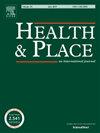邻里绿化可能会影响儿童、青少年和年轻人的甲状腺激素水平
IF 4.1
2区 医学
Q1 PUBLIC, ENVIRONMENTAL & OCCUPATIONAL HEALTH
引用次数: 0
摘要
人们越来越关注城市社区绿化对健康的益处,但对甲状腺激素水平的潜在影响尚不清楚,特别是对儿童、青少年和年轻人的影响。方法本纵向队列研究纳入57,198名年龄在6-25岁的台湾开放队列,观察时间为2000年至2017年。用免疫分析仪测定个体促甲状腺激素(TSH)和游离甲状腺素(FT4)水平。对每个参与者的地址进行归一化植被指数(NDVI)的年平均值计算。线性混合模型用于研究社区绿化与TSH和FT4之间的关系,并分别对男性和女性进行了分析。并对改性效果和潜在的介质进行了评价。结果本研究共纳入49690名受试者,71715个观察值。其中,女性占42.7%。在女性和男性中,社区绿化暴露与TSH水平呈负相关,而仅在女性中发现与FT4水平呈正相关。暴露于NDVI第三四分位数的妇女的TSH水平较低(−7.84e−2 μIU/ml, 95% CI:−15.01e−2,−0.67e−2)。暴露于NDVI第三和第四四分位数的雄性TSH水平分别降低了4.56e−2 μIU/ml (95% CI:−8.53e−2,−0.59e−2)和7.24e−2 μIU/ml (95% CI:−12.19e−2,−2.29e−2)。关于FT4水平,暴露于NDVI第二四分之一的女性FT4水平升高(2.01e - 2 ng/dl, 95% CI: 0.19e - 2, 3.82e - 2)。NDVI每增加一个SD, FT4增加0.65e−2 ng/dl (95% CI: 0.15e−2,1.15e−2)。结论本研究为社区绿化对年轻人甲状腺激素水平的影响提供了证据。这些发现可能揭示潜在的生物学机制,并有助于城市规划和公共卫生策略。本文章由计算机程序翻译,如有差异,请以英文原文为准。
Neighbourhood greenness might impact thyroid hormone levels in children, adolescents, and young adults
Background
Growing attention has been paid to the health benefits of neighbourhood greenness in urban cities, whereas the potential impacts on thyroid hormone levels remain unclear, particularly among children, adolescents, and young adults.
Methods
This longitudinal cohort study included 57,198 participants aged 6–25 years from an open cohort in Taiwan, observed from 2000 to 2017. Individual thyroid stimulating-hormone (TSH) and free thyroxine (FT4) levels were measured using immunoassay analysers. The annual average of Normalized Difference Vegetation Index (NDVI) was derived for each participant's address. Linear mixed models were used to investigate the associations between neighbourhood greenness and TSH and FT4, with analyses conducted separately for males and females. The modifying effects and potential mediators were also evaluated.
Results
49690 participants with 71715 observations were included in this study. Among them, 42.7 % of participants were females. Negative association was found between neighbourhood greenness exposure and TSH level for both females and males, while a positive association was found with FT4 levels only among females. Women exposed to the third quartile of NDVI had lower TSH levels (−7.84e−2 μIU/ml, 95 % CI: −15.01e−2, −0.67e−2) compared with those in the first quartile of NDVI. Decreased TSH levels of 4.56e−2 μIU/ml (95 % CI: −8.53e−2, −0.59e−2) and 7.24e−2 μIU/ml (95 % CI: −12.19e−2, −2.29e−2) were found in males exposed to the third and fourth quartile of NDVI, respectively. Regarding FT4 levels, women exposed to the second quartile of NDVI had increased FT4 levels (2.01e−2 ng/dl, 95 % CI: 0.19e−2, 3.82e−2). Each SD increase of NDVI was associated with 0.65e−2 ng/dl (95 % CI: 0.15e−2, 1.15e−2) increase of FT4.
Conclusion
Our study provided evidence on the impacts of neighbourhood greenness on thyroid hormone levels among young populations. These findings may reveal potential biological mechanisms and contribute to urban planning and public health strategies.
求助全文
通过发布文献求助,成功后即可免费获取论文全文。
去求助
来源期刊

Health & Place
PUBLIC, ENVIRONMENTAL & OCCUPATIONAL HEALTH-
CiteScore
7.70
自引率
6.20%
发文量
176
审稿时长
29 days
期刊介绍:
he journal is an interdisciplinary journal dedicated to the study of all aspects of health and health care in which place or location matters.
 求助内容:
求助内容: 应助结果提醒方式:
应助结果提醒方式:


